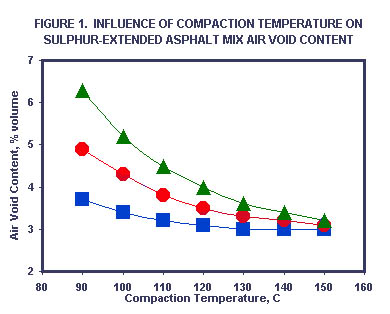|
Technical Note
INFLUENCE OF COMPACTION
TEMPERATURE
ON SEAM MIX AIR VOID CONTENT
Background
It has been observed in the field that
“rigid” 50%SEAM/50%Bitumen wt. binder mixes exhibit higher air void
contents after compaction than lower SEAM/Bitumen weight ratio mixes.
While studies by the U.S. Bureau of Mines* have
indicated that such “rigid”, high air void content mixes still exhibit
higher Marshall stabilities, even when densified at temperatures as low
as 85 °C, than highly compacted conventional asphalt
mixes, low mix air voids are generally favored by most agencies to
minimize mix access to air, in order to reduce bitumen oxidation, and to
reduce water intrusion in mix, in order to minimize moisture damage
potential. Actual field performance of higher void SEAM mixes has been
shown to be good. <Ref: SEA pavement evaluation [FHWA-Liddle &U 0f W-
Mahoney] Sulphur-84 International Conf. 1984>
Laboratory Mix Compaction Studies
Laboratory
Marshall compaction studies in Figure 1 confirm that while mix air void
content increases when mixes are compacted at a lower temperature, this
increase is not significant for the “flexible” 30%Sulphur/70%Bitumen mix
but starts to become significant at lower temperatures for the
“semi-rigid” 40%Sulphur/60%Bitumen mix and is very significant for the
“rigid” 50%Sulphur/50%Bitumen mix.
 |
<
30%Sulphur/70% Bitumen
l
40%Sulphur/60% Bitumen
p
50%Sulphur/50% Bitumen |
* Reference: US Department
of Transportation FHWA-IP-80-14
|
Recommendations
In order to reduce
mix air void content, it is recommended that SEAM mixes be compacted at
acceptably high temperature levels. The options for doing this are the
following:
1.)
“Tightening up” breakdown and
intermediate rolling to compact mixes immediately after placement.
2.)
Use of a mass transfer
vehicle (with a re-mixer) to improve mix temperature uniformity, and
thereby improve mix compaction potential.
3.)
Design “semi-rigid” and
“rigid” mixes to a lower air void content, e.g. 2% target, anticipating
the higher air void content in the field. This may require slight
changes in aggregate gradation.
|
![]()
